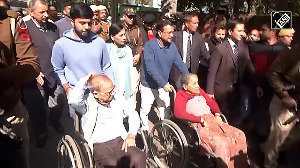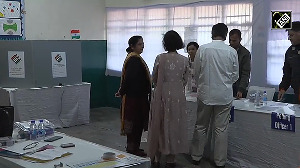Changing horses mid-stream, a la the mobile phone operator Telefonica Moviles Mexico. Is that what Reliance Communications is doing? RCL currently has only 2.2 mn GSM subscribers across eight circles. It claims it will grow both its GSM and CDMA networks.
Industry analysts, however, are inclined to believe that much like Telefonica or the Argentinian player CTI Movil - both of which switched over from CDMA to GSM - RCL too might be contemplating a similar move.
Reliance officials refused to confirm or deny this development. However, company sources said that "while such a move is not on the cards immediately, it may happen over a period of time".
That might be not be such a bad idea, say telecom analysts. RCL's announcement that it intends to beef up its networks in the existing eight circles (it wants to add 10-12 mn additional lines and cover 4,300 towns as against 330 towns currently) fits in neatly with this.
Why would RCL want to migrate to GSM when it has already built up a strong CDMA franchise - its market share at the end of May was 20.6 per cent and its total base was 19.3mn? Here's why?
CDMA is considered to be the superior technology, especially for data services which high-value customers demand. That's why in markets such as the US, ARPUs (average rate per user) from CDMA networks are far higher.
Companies such as Verizon and Sprint position their networks as high-quality service networks and earn better ARPUs. However, despite this, only around 15 per cent of the world uses CDMA - the main markets being the US and Korea.
In India, however, the advantages of the superior CDMA technology have been outweighed by the huge demand for international roaming services and the wider range of handsets available for GSM users.
Analysts point out that while it is not impossible to roam in CDMA countries, it can be difficult. This is why many users prefer GSM.
What has probably made CDMA less popular with some users is that one cannot change service providers without changing the handsets.
Since a large percentage of user base would be at the lower end, which is not looking for international roaming, but wants variety in handsets, GSM has had its share of fans.
Besides, there is talk that number portability is around the corner and perhaps the time is not far off when users can access both technologies from the same instrument.
Obviously the migration, assuming that's the gameplan, would happen over three to four years. "The cost of equipment has reduced significantly in the last four or five years when players like Bharti were rolling out their networks. Equipment now costs about half of what it used to or in some cases even less," observes a telecom consultant.
The cost of rolling out the network for Delhi and Bombay, according to the RCL management will be much lower than if it were a greenfield venture.
It claims it will save as much as 30 per cent on basic infrastructure: that's because the cell sites, the steel structures and the back haul network will be common to both CDMA and GSM networks.
Besides, it claims it would save another 15 per cent on distribution - it will use its 200 Web Worlds to sell the GSM service.
Moreover, it would not need to spend too much additionally on branding though it may create a sub-brand.
So while a newcomer might have to spend between Rs 2000 -2500 crore (Rs 20-25 billion) on the Delhi and the Mumbai networks, RCL would need to spend just about half of that.
However, given the strong competition in the GSM space with players such as Bharti and Hutch, RCL will need to spruce up its image.
Demystifying GSM & CDMA
GSM (Global System for Mobile communications) is the "branded" term referring to a particular use of TDMA (Time-Division Multiple Access) technology. It operates on four separate frequencies. You will find the 900 MHz and 1,800 MHz bands in Europe and Asia and the 850 MHz and 1,900 MHz bands in North America and Latin America.
CDMA (Code Division Multiple Access), on the other hand, offers more efficient use of analog transmission since it allows greater frequency reuse, as well as increases battery life, improves the rate of dropped calls, and offers far greater security than GSM/TDMA.






 © 2025
© 2025